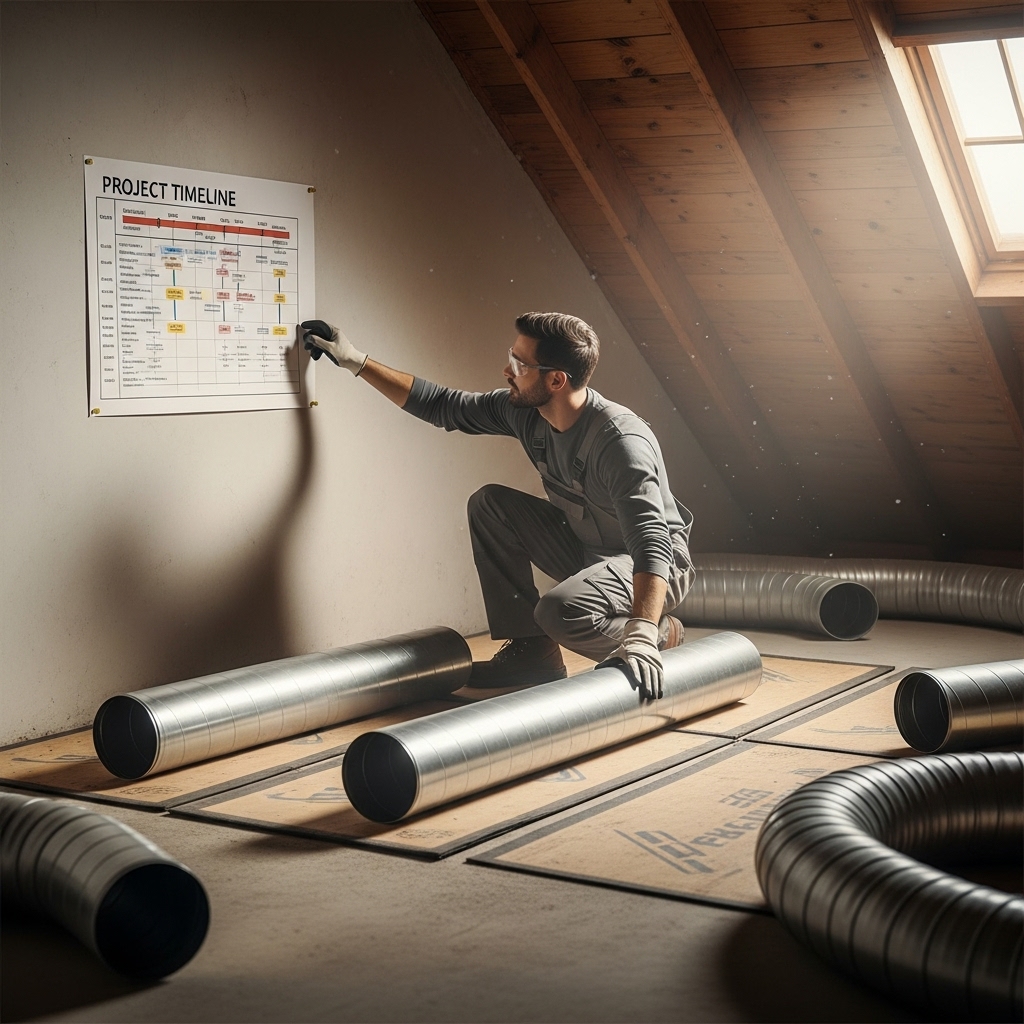The Air Duct Replacement Process and Timeline in Malibu
Replacing air ducts is more than a swap of old for new. It is a coordinated process that brings design, materials, workmanship, and verification together to produce balanced airflow and lasting comfort. In Malibu, where many homes rely on attic ducts that endure hot summers and cooler winter nights, a well-managed project can transform your day-to-day experience. This guide breaks down each stage—from the first inspection to the final walkthrough—so you know what to expect, how to prepare, and how a quality-focused contractor keeps the work on track. If you are starting the planning phase, now is the perfect time to learn the steps of professional duct replacement and how thoughtful coordination supports predictable timelines.
The process typically unfolds in phases: discovery and planning, preparation and protection, removal and installation, and testing and balancing. While every home is unique, understanding these phases helps you follow along and ask the right questions. A transparent schedule and proactive communication ensure that crews arrive prepared, materials are staged efficiently, and any surprises are handled without derailing progress.
Phase 1: Discovery and Planning
The project begins with a comprehensive assessment. Technicians document the existing system, note damage or contamination, and listen to your comfort concerns. They evaluate supply and return strategies, check airflow and static pressure, and look for pinch points such as crushed branches or undersized returns. From there, the team creates a design that aligns ducts with room-by-room airflow needs, specifying materials and insulation to match attic or crawlspace conditions common in Malibu.
- Room-by-room airflow assessment to guide sizing and layout.
- Return strategy to relieve pressure imbalances and reduce noise.
- Material selection based on durability, accessibility, and code requirements.
- Sealing and insulation standards appropriate for local climate conditions.
Phase 2: Preparation and Protection
Before installation begins, your contractor will coordinate logistics. They will establish clear access routes to attics or crawlspaces, lay down protective coverings, and discuss staging locations for tools and materials. This focus on preparation helps the crew work efficiently and keeps your living areas clean. Good teams also plan for waste removal and end-of-day cleanup, so your home remains orderly throughout the project.
Phase 3: Removal of Existing Ductwork
Careful removal is essential to protect your home and maintain cleanliness. Technicians detach branches and trunks methodically, cap or cover openings as needed, and avoid disturbing insulation unnecessarily. In attic projects, crews use platforms to protect ceilings and minimize the risk of damage. Materials are bagged or bundled to keep dust contained during removal from the home.
Phase 4: Installation of New Ducts
Installation is where design meets craftsmanship. Trunks are set first, sized to carry the required airflow with minimal pressure drop. Branch runs follow, routed with gentle bends, proper support spacing, and secure connections. All seams and joints are sealed with mastic and mechanically fastened as appropriate. Boots are aligned carefully with grilles to prevent air leaks around drywall or flooring. For Malibu’s climate, insulation levels are chosen to limit heat gain in attics and support stable supply temperatures.
- Trunks and branches sized to design airflow.
- Smooth routing to reduce turbulence and noise.
- Mastic sealing at all joints, seams, and boots.
- Support spacing that prevents sagging and kinks.
- Insulation matched to attic or crawlspace conditions.
Phase 5: Testing, Balancing, and Verification
Once installation is complete, technicians verify performance with airflow and static pressure measurements. Balancing dampers are adjusted to fine tune room-by-room comfort. The team confirms temperature splits, checks register alignment, and inspects for full sealing and insulation coverage. Documentation—such as photos and readings—demonstrates that the system matches the design and supports long-term performance.
Timeline Considerations
The duration of a duct replacement project depends on home size, layout complexity, access to attics or crawlspaces, and whether design changes are implemented. Clear planning, staged materials, and an organized crew help keep the schedule predictable. While some homes can be completed in a relatively short window, others—especially those with multiple stories or significant design improvements—can take longer. Your contractor should provide a timeline that accounts for inspection, material procurement, installation, testing, and cleanup.
What You Can Do to Keep the Project on Schedule
- Provide access to attics, crawlspaces, and mechanical rooms.
- Move fragile items near registers and returns.
- Discuss parking and staging areas before work begins.
- Confirm any design decisions in advance to avoid mid-project delays.
- Stay available for quick approvals if unexpected conditions arise.
Local Factors in Malibu
Attic temperatures, dust from dry conditions, and older building stock in parts of the area mean that crews must balance careful navigation with efficient workflow. Experienced local teams understand how to secure materials, work during cooler parts of the day when possible, and protect your home from debris. They also understand local code implications for insulation levels, supports, and fire safety requirements.
Quality Standards That Support Predictable Results
Top-performing contractors use checklists and standardized methods to ensure consistent outcomes. That includes verifying support spacing for flexible duct, maintaining proper bend radii, sealing every connection with mastic, and inspecting boots for airtight alignment with registers. These practices reduce call-backs, keep schedules tight, and ensure the finished system performs as designed.
Mid-Project Communication
Clear communication keeps everyone aligned. If crews encounter blocked chases, damaged boots behind grilles, or hidden junctions, they should document the issue, share photos, and offer solutions that maintain design integrity. With your approval, adjustments are made efficiently so the project continues smoothly and the final system meets your expectations for air duct replacement.
After the Installation: What to Expect
Following installation and testing, the team will conduct a walkthrough. They will show you balancing adjustments, explain how register settings influence airflow, and review documentation. You should receive guidance on filter changes and basic maintenance practices that support cleanliness and performance over time.
Frequently Asked Questions
Q: How do I know if my ducts need replacement rather than repair? A: Widespread leakage, crushed runs, outdated layouts, or contamination that cannot be remediated safely often point to replacement. A professional evaluation with documentation helps you decide.
Q: Will the crew protect my home during the project? A: Yes. Look for teams that describe floor protection, debris control, and end-of-day cleanup. Ask about how they navigate attics to protect ceilings and insulation.
Q: Can I live in my home during the work? A: In most cases, yes. Expect some noise and activity. Crews will isolate work areas and keep common spaces clean.
Q: How is performance verified? A: Technicians measure airflow and static pressure, confirm temperature splits, and provide photo documentation of sealing and insulation practices.
Q: What if hidden issues are discovered? A: Reputable contractors will communicate findings, propose solutions, and proceed with your approval to maintain the project’s quality and schedule.
How to Prepare for a Smooth Replacement
- Schedule your evaluation when you can be present for questions and approvals.
- Clear access and identify a staging area for tools and materials.
- Share your comfort priorities so balancing can be tailored to your routine.
- Plan for pets and coordinate household schedules to minimize disruptions.
Benefits You Will Notice
After a well-planned duct replacement, most homeowners notice steadier temperatures, quieter registers, and improved cleanliness around vents. Balanced returns create a sense of calm airflow throughout the home, and the system requires less agonizing thermostat adjustment from room to room. Over time, the improved duct system supports reliable HVAC performance through Malibu’s seasonal swings.
From Planning to Performance
The most successful projects start with a clear design and end with documented results. When crews follow a step-by-step process, communicate proactively, and verify performance, you benefit from predictable timelines and a home that feels comfortable across seasons.
Take the Next Step for a Predictable Project
Begin with a thorough in-home assessment that ties your comfort goals to a clear plan, schedule, and documentation. When you are ready to move forward, partner with a team that treats design, sealing, insulation, and verification as essential steps for high-quality duct replacement in Malibu.

